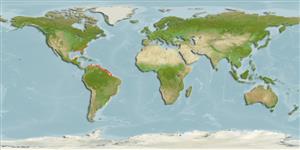Teleostei (teleosts) >
Eupercaria/misc (Various families in series Eupercaria) >
Sciaenidae (Drums or croakers)
Etymology: Stellifer: Latin, stella = satr + latin, fero = to carry (Ref. 45335).
More on author: Jordan.
Environment: milieu / climate zone / depth range / distribution range
Ecology
Marine; brackish; demersal; depth range ? - 40 m (Ref. 9626), usually ? - 20 m (Ref. 9626). Tropical
Western Atlantic: Colombia to southern Brazil (Ref. 3702) and range extended to Uruguay (Ref.
Length at first maturity / Size / Weight / Age
Maturity: Lm 9.8 range ? - 16 cm
Max length : 32.1 cm TL male/unsexed; (Ref. 94907); common length : 15.0 cm TL male/unsexed; (Ref. 5217); max. published weight: 70.20 g (Ref. 118626)
Occurs in coastal waters, over soft, muddy bottoms (Ref. 5217). Abundant in brackish estuaries (Ref. 5217). Feeds mainly on small crustaceans, often hunting in schools (Ref. 4537, 35237). Mostly used in the manufacture of sub-products (Ref. 3702).
Cervigón, F., 1993. Los peces marinos de Venezuela. Volume 2. Fundación Científica Los Roques, Caracas,Venezuela. 497 p. (Ref. 9626)
IUCN Red List Status (Ref. 130435)
Threat to humans
Harmless
Human uses
Fisheries: minor commercial
Tools
Special reports
Download XML
Internet sources
Estimates based on models
Preferred temperature (Ref.
123201): 22.9 - 28, mean 25.4 °C (based on 386 cells).
Phylogenetic diversity index (Ref.
82804): PD
50 = 0.5000 [Uniqueness, from 0.5 = low to 2.0 = high].
Bayesian length-weight: a=0.00813 (0.00694 - 0.00952), b=3.10 (3.08 - 3.12), in cm total length, based on LWR estimates for this species (Ref.
93245).
Trophic level (Ref.
69278): 3.4 ±0.2 se; based on diet studies.
Resilience (Ref.
120179): Medium, minimum population doubling time 1.4 - 4.4 years (Fec=6,926 (batch fecundity)).
Fishing Vulnerability (Ref.
59153): Low vulnerability (22 of 100).
Nutrients (Ref.
124155): Calcium = 176 [104, 346] mg/100g; Iron = 1.15 [0.62, 2.00] mg/100g; Protein = 19 [18, 20] %; Omega3 = 0.234 [0.125, 0.389] g/100g; Selenium = 46.3 [25.9, 87.0] μg/100g; VitaminA = 19.9 [8.0, 52.6] μg/100g; Zinc = 1.47 [1.08, 2.09] mg/100g (wet weight);
